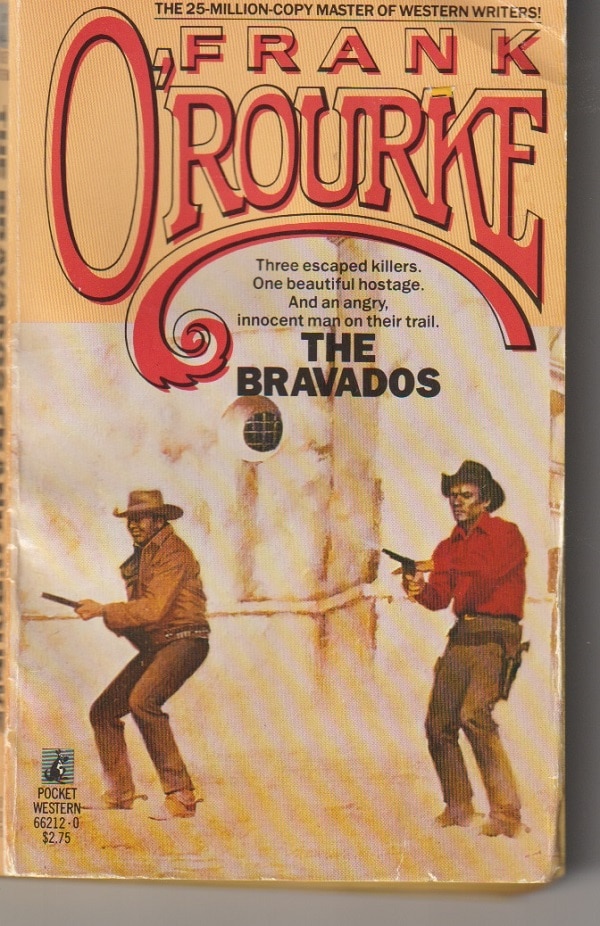In 1958, Gregory Peck starred as the revenge-driven Jim Douglass in the brooding and beautiful western The Bravados.
The movie was based on a novel of the same name, published the year before by Frank O’Rourke, and, as is the nature of these things, the filmmakers, particularly screenwriter Philip Yordan, changed much of the story.
In the movie, Douglass became the central character. He has chased three men for the murder of his wife and arrives in town for their execution for another crime.
The three break out of jail with a fourth convict, taking a young woman as hostage. Douglass leads the chase. One by one, he kills three of the men, but not before one rapes the hostage, and is closing in to kill the fourth when the plot takes a sharp twist that skews the simple morality tale completely — and satisfyingly — out of shape.
The book is both simpler and more complex. Douglas (one ‘s’) is in jail with the bad guys because Gus Steinmetz, the local store owner, noted for his greed, wants to get back at him for underbidding him on a supply contract for the nearby mine.

Steinmetz also happens to be the father of Emma, the girl Douglas has been sort of dating. In addition to revenge, the jailing seems to be an effort to put the young man in his place so that, as a suitor, he’ll be more pliable.
Two women
Emma is one of two prominent young women in the book to whom Douglas is attracted. The other is Josefa Velarde, the take-charge, hard-riding daughter of the owner of the major ranch in the area.
O’Rourke describes Emma:
Emma was a round-bodied girl with soft brown hair and white skin, wide-set eyes and short nose, and a thick, greedy mouth. She looked so sweet, so innocent, but that pretty face concealed a carbon copy of her father’s shrewd stubbornness. She wanted Douglas but only on her father’s terms.
O’Rourke describes Josefa:
Handling the black stallion as if it were a colt was a thin girl with jet black hair. Douglas saw that her nose was too big and her mouth too wide, and she had a strained, ugly look in this moment. She was skinny compared to most girls in the valley, especially a girl of Emma’s form, but that thinness in the girl was arrow-straight and hard as steel.
Faults
Unlike the movie, Douglas shares the spotlight with Eloy Sanchez, the town sheriff who leads the chase of the killers, one of whom killed the sheriff’s cousin — by drowning him in a bucket — to make their escape.
Douglas is important in that search as well, and, unlike the movie, so is Josepha.
O’Rourke’s novel has some faults. The three men who escape are clearly very bad men, as is Gus Steinmetz. Douglas, Sanchez, Josefa and those taking up the chase are clearly the good guys (and girl). The moral lines are too clear-cut.
The only character with moral ambiguity is Emma Steinmetz who, as the hostage, is the victim of the violence — and a victim of rape. She later tries to trick Douglas into courting her again and ends up looking almost as bad as her father.
Another fault of the book is the flippant talk about the rape in the final pages.
A crackerjack job
Nonetheless, O’Rourke does a crackerjack job of describing the jail break and the dragnet through wild country as Sanchez’s forces try to save the girl — and Josefa’s prize horse — and bring the killers to justice.
Aspects of the story were a refreshing divergence from the movie version and the general Hollywood tropes for westerns. For instance, when the killers break out, they don’t just grab horses that happen to be handy (as they do in the movie). Instead, they have to walk several miles to Josefa’s ranch to steal some.
Another nice wrinkle is Josefa’s obsession with recovering her elite mare. This seems a valid glimpse into the 19th century culture in the southwest where horses were more than simply possessions but partners with their human owners.
I found Gregory Peck’s version of The Bravados to be a triumph as a movie.
O’Rourke’s novel isn’t quite as good. But it is well-done, well-paced and well worth reading.
.
Patrick T. Reardon
2.3.21
Written by : Patrick T. Reardon
For more than three decades Patrick T. Reardon was an urban affairs writer, a feature writer, a columnist, and an editor for the Chicago Tribune. In 2000 he was one of a team of 50 staff members who won a Pulitzer Prize for explanatory reporting. Now a freelance writer and poet, he has contributed chapters to several books and is the author of Faith Stripped to Its Essence. His website is https://patricktreardon.com/.
